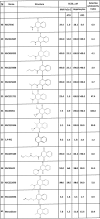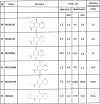Targeting mitochondria in cancer therapy could provide a basis for the selective anti-cancer activity
- PMID: 30908483
- PMCID: PMC6433232
- DOI: 10.1371/journal.pone.0205623
Targeting mitochondria in cancer therapy could provide a basis for the selective anti-cancer activity
Abstract
To determine the target of the recently identified lead compound NSC130362 that is responsible for its selective anti-cancer efficacy and safety in normal cells, structure-activity relationship (SAR) studies were conducted. First, NSC13062 was validated as a starting compound for the described SAR studies in a variety of cell-based viability assays. Then, a small library of 1,4-naphthoquinines (1,4-NQs) and quinoline-5,8-diones was tested in cell viability assays using pancreatic cancer MIA PaCa-2 cells and normal human hepatocytes. The obtained data allowed us to select a set of both non-toxic compounds that preferentially induced apoptosis in cancer cells and toxic compounds that induced apoptosis in both cancer and normal cells. Anti-cancer activity of the selected non-toxic compounds was confirmed in viability assays using breast cancer HCC1187 cells. Consequently, the two sets of compounds were tested in multiple cell-based and in vitro activity assays to identify key factors responsible for the observed activity. Inhibition of the mitochondrial electron transfer chain (ETC) is a key distinguishing activity between the non-toxic and toxic compounds. Finally, we developed a mathematical model that was able to distinguish these two sets of compounds. The development of this model supports our conclusion that appropriate quantitative SAR (QSAR) models have the potential to be employed to develop anti-cancer compounds with improved potency while maintaining non-toxicity to normal cells.
Conflict of interest statement
The authors have declared that no competing interests exist. Q-MOL LLC commercial affiliation does not alter our adherence to PLOS ONE policies on sharing data and material.
Figures










References
-
- Pervaiz S, Clement MV. Tumor intracellular redox status and drug resistance—serendipity or a causal relationship? Curr Pharm Des. 2004; 10: 1969–7197. - PubMed
Publication types
MeSH terms
Substances
LinkOut - more resources
Full Text Sources
Miscellaneous

